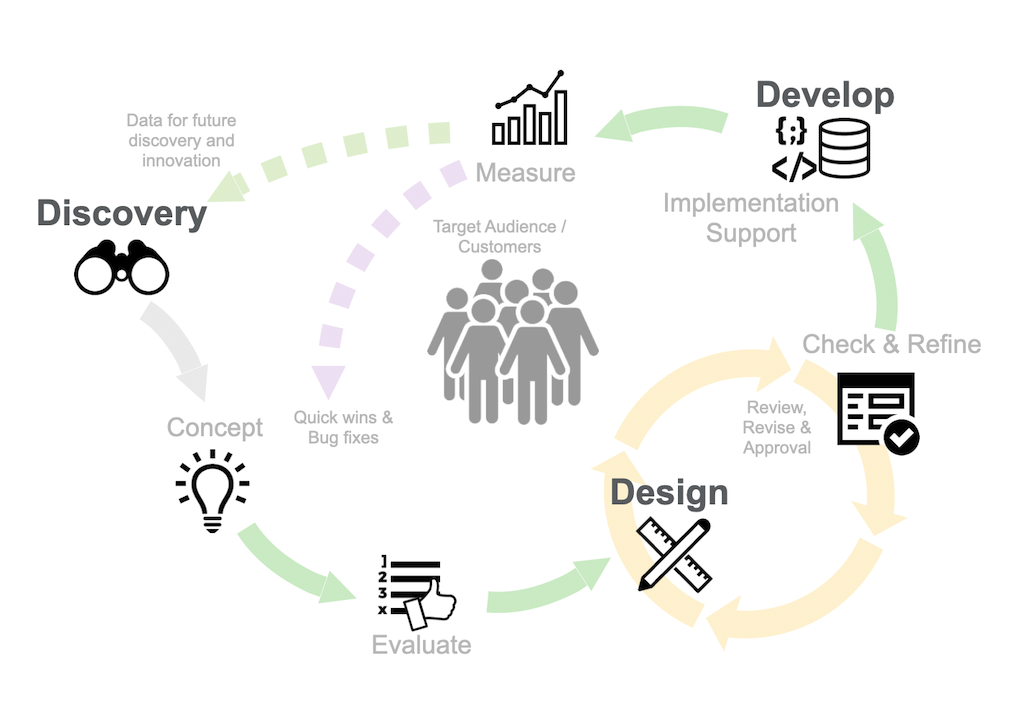
Any user-centered process is going to have Discovery, Design, and Development phases as part of the cycle
Download the Detailed Experience Design & Research Cycle PDF
The following is an outline of the range of Experience Design & Research activities that can be used to create great experiences. Note that these activities and their deliverables can be adapted to any software development life cycle; waterfall, agile, hybrid. In general there will be a discovery, design, and develop phase in any given project with only the activities that are required to guide and support each phase being utilized as needed.
-
Discovery
The Discovery phase will involve any activities that explore the problem space and analyzing any data that can be used to inform the understanding of the problem. It is all too common for teams to jump straight to solutions, which almost always leads to poor outcomes. Of course there will be constraints on how much time can be spent in discovery, but my experience has been that few teams spend hardly anytime trying to understand the problem they are trying to solve.
Activities & Deliverables
- Discovery Workshops / interviews with business stakeholders, project team members and users as needed.
- Surveys and analysis
- Analysis of site / app statistics and reporting from analytical tools
- Conduct ethnographic / field studies, customer interviews, and contextual inquiries, create affinity diagrams/maps, task sequences / flows, personas, and experience journey maps.
- Conduct benchmark / summative usability testing, analysis and reports with recommendations
- Conduct heuristic reviews and analysis of the industry and chief competitors.
- Create a vision presentation and/or prototype.
- Create an Experience roadmap (aligned or as supplemental to the product roadmap).
-
Design
The Design phase should be an iterative process of generating, reviewing and validating solutions. One of the biggest things teams miss when estimating the time and work for this phase is the need for reviews and revisions. This is especially true for internal teams where there may not be any accounting of the designers having to rework the design based on stakeholder feedback or technical limitations. There are 3 sub-phases to the design phase that cycle from creating to reviewing and revising.
Activities & Deliverables
Early phase
- Design Discovery Workshops
- Plan card sorts and cluster analysis
- Content Inventory / Review
- Sketching / Whiteboarding
- Wireframing / prototyping
- Screen Mock-ups
Core phase
- Requirements Refinement
- Design Workshops
- Sketching
- Wireframing / Prototyping
- Formative / Exploratory Usability Tests
- Visual Designing
Review & Refine phase
- Stakeholder Reviews and Revision Cycles
- Formative / Exploratory Usability Tests
- 5 second Tests
- Click Tests
- Finalize requirements
- Finalize Designs
Develop
The Development phase involves supporting the development and QA teams with resolving any unknown technical and data issues which affect the design. It can also involve research activities to mitigate risks prior to launch. Here again, especially for agile teams, many do not account for the need of the designers to support added design work to accommodate those issues identified late in the cycle. For waterfall teams this involves delivery of final wireframes/visual design specifications. Usability testing done during this phase can typically only serve the purpose of risk mitigation and minor revisions. Any major issues uncovered will require a launch to be delayed.
Activities & Deliverables
- Prepare Assets for delivery to development (redlines & graphic / sprite exporting)
- Final Wireframes, task flows, site maps, user stories, prototypes
- Interface/visual design: Screen mocks, hi-fi prototypes, final graphics-html-css
- Prototype review with dev and QA teams
- QA/UAT support
Late phase research
- Summative Usability Testing
- A / B testing
- Beta Launch